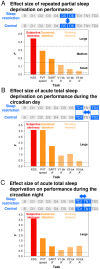Effects of partial and acute total sleep deprivation on performance across cognitive domains, individuals and circadian phase
- PMID: 23029352
- PMCID: PMC3454374
- DOI: 10.1371/journal.pone.0045987
Effects of partial and acute total sleep deprivation on performance across cognitive domains, individuals and circadian phase
Abstract
Background: Cognitive performance deteriorates during extended wakefulness and circadian phase misalignment, and some individuals are more affected than others. Whether performance is affected similarly across cognitive domains, or whether cognitive processes involving Executive Functions are more sensitive to sleep and circadian misalignment than Alertness and Sustained Attention, is a matter of debate.
Methodology/principal findings: We conducted a 2 × 12-day laboratory protocol to characterize the interaction of repeated partial and acute total sleep deprivation and circadian phase on performance across seven cognitive domains in 36 individuals (18 males; mean ± SD of age = 27.6 ± 4.0 years). The sample was stratified for the rs57875989 polymorphism in PER3, which confers cognitive susceptibility to total sleep deprivation. We observed a deterioration of performance during both repeated partial and acute total sleep deprivation. Furthermore, prior partial sleep deprivation led to poorer cognitive performance in a subsequent total sleep deprivation period, but its effect was modulated by circadian phase such that it was virtually absent in the evening wake maintenance zone, and most prominent during early morning hours. A significant effect of PER3 genotype was observed for Subjective Alertness during partial sleep deprivation and on n-back tasks with a high executive load when assessed in the morning hours during total sleep deprivation after partial sleep loss. Overall, however, Subjective Alertness and Sustained Attention were more affected by both partial and total sleep deprivation than other cognitive domains and tasks including n-back tasks of Working Memory, even when implemented with a high executive load.
Conclusions/significance: Sleep loss has a primary effect on Sleepiness and Sustained Attention with much smaller effects on challenging Working Memory tasks. These findings have implications for understanding how sleep debt and circadian rhythmicity interact to determine waking performance across cognitive domains and individuals.
Conflict of interest statement
Figures






References
Publication types
MeSH terms
Substances
LinkOut - more resources
Full Text Sources

